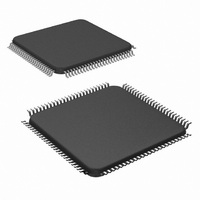LM9833CCVJD/NOPB National Semiconductor, LM9833CCVJD/NOPB Datasheet - Page 36

LM9833CCVJD/NOPB
Manufacturer Part Number
LM9833CCVJD/NOPB
Description
IC USB IMAGE SCAN 48BIT 100-TOFP
Manufacturer
National Semiconductor
Datasheet
1.LM9833CCVJDNOPB.pdf
(42 pages)
Specifications of LM9833CCVJD/NOPB
Number Of Bits
16
Number Of Channels
3
Voltage - Supply, Analog
5V
Voltage - Supply, Digital
4.5 V ~ 5.5 V
Package / Case
100-TQFP, 100-VQFP
Lead Free Status / RoHS Status
Lead free / RoHS Compliant
Power (watts)
-
Other names
*LM9833CCVJD
*LM9833CCVJD/NOPB
LM9833CCVJD
*LM9833CCVJD/NOPB
LM9833CCVJD
Applications Information
12.16 Paper Sensor #2 Doesn’t Stop High Speed Reverse
In the LM9831, a false-to-true transition on Paper Sensor #2
would stop a high speed reverse (usually used for homing in flat-
bed scanners). Due to the changes made to accommodate the
FullStep Timeout Function function, the ability to stop a high
speed reverse function was removed.
12.17 Turbo and Preview Modes
These modes actually existed in the LM9831, but were not docu-
mented.
The Turbo and Preview modes allow additional pixel averaging
(horizontal resolution reduction) to be done in the analog domain.
This can be useful, for example, when you have a 1200 dpi scan-
ner and wish to scan at 75 or 50dpi. The HDPI divider function’s
lowest resolution is divide-by-12. With the HDPI divider set to
divide-by-8 and turbo or preview mode set to x2, the horizontal
resolution will be 1200/16 = 75dpi. With the HDPI divider set to
divide-by-12 and turbo or preview mode set to x2, the horizontal
resolution will be 1200/24 = 50dpi. The HDPI divider and
Turbo/Preview modes can be used in any combination.
For a Preview factor of xN, the Preview Mode operates by
increasing the pixel clocks to the CCD by a factor of N, while sup-
pressing (N-1) reset pulses out of every N pixels. This is only use-
ful for CCDs (or CIS sensors made with CCD technology).
In the Turbo Mode, the entire analog front end is run N times
faster, and every N pixels are averaged together before they are
converted to digital by the ADC. When using Turbo Mode, the
range of registers 0F to 18 is reduced by the Turbo Mode factor,
according to the following table:
13.0 PORTING SOFTWARE FOR LM9830 TO LM9833
The LM9833 is similar in architecture to the LM9830. Porting a
TWAIN driver from the LM9830 to the LM9833 is relatively
straightforward if consideration is given to the following issues.
The LM9833 includes almost all the features of the LM9830, plus
3 Channel,
3 Channel,
3 Channel,
3 Channel,
3 Channel,
1 Channel,
1 Channel,
Turbo off
Turbo off
Turbo x2
Turbo x3
Turbo x4
Turbo x6
Turbo x2
Mode
Pixel Rate
MCLK/24
MCLK/12
MCLK/8
MCLK/6
MCLK/4
MCLK/8
MCLK/4
(Continued)
Registers
0F to 18
Range
0 - 23
0 - 11
0 - 7
0 - 5
0 - 3
0 - 7
0 - 3
36
several new ones. The first step is to change the LM9830 Twain
driver so that it works with the LM9833. The second step is to
take advantage of the new features of the LM9833 that will allow
you to obtain even better, faster scans than you obtained with the
LM9830.
13.1 Porting Step 1
13.1.1 Adjust for Register Changes
While more than 50% of the registers in the LM9833 are in the
same location and perform the same function as they did in the
LM9830, many other registers have changed. Sometimes the
address of a register changed, sometimes the location of the bits
inside a register were moved, some register settings were com-
bined or deleted, and the size of some registers was changed.
Please compare the register listings for the LM9830 and LM9833
carefully. This is a list of registers that have changed:
Registers 1, 2, 3, 4, 7, 9, B, 19, 1A, 1B, 3E-41, 42, 43-44, 4E-4F,
51-53, 54, 5A, 5B, 5E.
13.1.2 Choosing the MCLK Divider (Register 0x08)
The datarate coming out of the Horizontal DPI Divider must be
1.1MHz or less. If it is faster than this, the LM9833 will not oper-
ate correctly. Since the maximum USB datarate is about 1MHz,
this does not impact the performance of the scanner in any way.
This is the Clock Divider Rule:
The ITA (Integration Time Adjust) refers to register 19, and will be
discussed in a later section. If register 19 = 0, then the value of
ITA = 1 for the purposes of this formula.
If register 19 = 0, this formula means that if the HDPI_divider = 1,
the MCLK_divider must be set to divide-by-6 (reg 08 = 10 [deci-
mal]) or higher. If the HDPI_divider = 4, the MCLK_divider must
be set to divide-by-2 (reg 08 = 2) or higher. If the HDPI_divider is
6 or larger, then the MCLK_divider can be set to divide-by-1
(reg08 = 0).
See 13.2.2 Integration Time Adjustment Function for addi-
tional information.
13.1.3 Calibration
In the LM9830, calibration was always performed at the optical
resolution of the scanner. For example, if the optical resolution of
the scanner was 600dpi, then calibration was performed at
600dpi even if the scan was going to be at 300dpi or 150dpi.
To keep the speed of the LM9833 high while using slower DRAM
(instead of SRAM), the architecture of the LM9833 was changed
so that the Horizontal DPI adjust function is performed before the
pixel rate offset and shading correction, instead of after (as in the
LM9830).
This means that the calibration routine needs to be changed so
that register 9 is set to the desired scan resolution before calibra-
tion.
13.1.4 Pixel Rate Offset Correction
The LM9833 uses 16 bits for the offset correction of each pixel.
(MCLK_divider)(HDPI_divider)(ITA) >= 6
www.national.com










